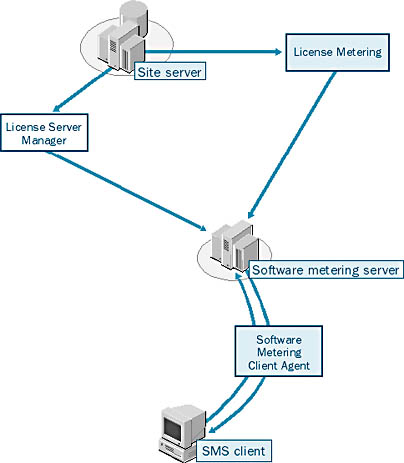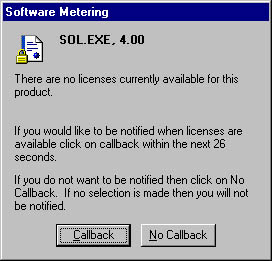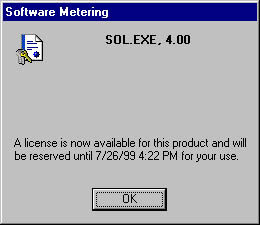Overview
The SMS 2.0 Software Metering tool provides application tracking support in two related areas: software usage and software restrictions. "Software usage" refers to when an application starts on the client, who started it, how long the application ran, how many instances of the application were run, and so on. "Software restrictions" refer to the actual licenses available for the application and license usage, stopping unauthorized applications from running, and placing time and user restrictions on an application, much like creating an access control list (ACL) for a file or folder in Windows NT.
Four main systems participate in the software metering process, whether you are tracking usage or restricting access: the site server, the software metering server and its data cache, the software metering database server, and the SMS client running the Software Metering Client Agent.
The site server, as always, acts as the configuration point for software metering. The site server is where you configure the SMS components that support software metering, including defining which site system will become the software metering server. The site server is also where you will configure, register, or exclude applications for metering and where you will define the number of licenses available and how to balance license information across the software metering servers.
The software metering server is itself the point of contact for the SMS clients. It receives configuration and license information from the site server, it stores usage information reported by the client agents, and it responds to client requests for application access and licenses. The software metering server maintains this license and usage data in its own local data cache (a FoxPro database engine), which it makes available to the site server on a periodic basis.
The software metering data is stored in its own SQL database. This database is separate from the SMS database; unlike the SMS database, it does not require Windows Management Instrumentation (WMI) access or support. The data is viewed through the Software Metering tool, which is installed on the SMS Administrator Console when you select Software Metering as one of the SMS Custom Setup options.
The Software Metering Client Agent is configured through the site server and installed on the SMS clients in much the same fashion as other client agents. Its purpose is to report usage data to the software metering server, request licenses, and update component information on the client such as the excluded programs list.
Software Metering Process Flow
The software metering process, shown in Figure 14-1, begins at the site server, of course. From the SMS Administrator Console on the site server, you configure the Software Metering component and assign the software metering server role to designated site systems. When you select the Software Metering component from the SMS Administrator's Console on the site server, you configure the License Metering process thread. License Metering is responsible for maintaining product configurations such as permitted users, time restrictions, license checkouts, and so on; determining license usage trends; balancing licenses among software metering servers in the same site and across sites; maintaining and forwarding a list of excluded products for the software metering server; copying metered and configuration data from and to the software metering server; and summarizing the metered data.

Figure 14-1. Software metering process flow.
![]()
MORE INFO
You can also find detailed flowcharts that outline the various tasks performed by the Software Metering tool and its components in the Systems Management Server Administrator's Guide, and also in Chapter 22 of the SMS 2.0 Resource Guide (part of the Microsoft BackOffice 4.5 Resource Kit, available through Microsoft Press).
When you assign the software metering server role to a site system, the License Server Manager component is responsible for installing the appropriate support components on that site system. License Server Manager creates and installs the software metering data cache in the SWMTR folder, shares the folder as LICMTR, creates the SWMAccount service account, and starts and loads the SMS License Service on the software metering server. The service account will then be used by the SMS License Service.
Once it has been configured, the software metering server makes license and other reporting configuration information available to the SMS clients and receives metered data from the clients. This server does not itself make any connections to either the SMS client or the site server as part of the software metering process. Instead, the Software Metering Client Agent connects to the software metering server to download license and other configuration information to the client and to copy metered data, callback requests, and other data to the software metering server's data cache. The main function of the SMS License Service on the software metering server is to provide or decline software access to the client agent.
If you have configured the Software Metering component to track software usage on the client, the client agent is directed to collect information about the applications running on the client computers. When an application is started—and if it has not been excluded—the client agent gathers its usage information and sends the information to the software metering server. The client agent reports the client on which the application was executed, when the client was started, when the client was stopped, how long the application ran, and the logged on user that initiated the program. This data is then stored as part of the software metering server's data cache.
Software metering operates in one of the two modes: offline and online. If you are running the client agent in offline mode, this usage information is stored on the client and reported to the software metering server on a periodic schedule. Operating in offline mode means that you have not enabled real-time license verification for the client agent. Offline mode is the default; it provides passive monitoring of application usage. If the client cannot connect to the software metering server for whatever reason—for example, if the client is a laptop and is not currently connected to the local network—the usage data is stored locally on the client until a connection to the software metering server can be made.
Online mode is enabled by turning on real-time license verification for the client agent. In this case, software usage is reported by the client agent dynamically. In addition, through online mode, the Software Metering Client Agent checks the software metering server for any restrictions or available licenses for the application that is being started. As mentioned, the SMS License Service on the software metering server is responsible for granting or denying access. If user restrictions or time restrictions exist, or if not enough licenses are available for the application, the application will be prevented from running by the client agent.
If no licenses are available, the Software Metering Client Agent displays a message to that effect on the client computer, asking whether the user would like a callback, as shown in Figure 14-2. If the user accepts the callback, the SMS License Service monitors the application licenses in question.

Figure 14-2. A callback request to the user when a program cannot be run due to unavailable licenses.
The callback request is placed in a callback queue and remains in the queue for a specified period of time—by default, 30 minutes. After the specified period of time has passed, the request is dropped from the queue, and the user who requested the callback must generate another license request. During the time the request is in the queue, the client agent periodically checks the software metering server (every 5 minutes by default) to see whether a license has become available and has been reserved for the user. When it finds that a license has been made available, the client agent displays another message to the user to that effect, as shown in Figure 14-3, which also notes the grace period during which the license will be reserved for the user. If the user does not start the application within that grace period—by default, 10 minutes—the reserved license goes back into the pool of available licenses and is fair game to any other client.

Figure 14-3. Message box notifying user that a license has become available.
As mentioned, usage and license data are copied to the software metering server by the Software Metering Client Agent. The License Metering process thread on the site server copies software usage and callback data as well as license usage and restrictions data from the software metering server and updates the software metering database.
Software metering configuration data such as new product licenses and excluded programs is passed from a parent site to its child sites. Data about application and license usage, callback requests, and so on is passed from the child site to its parent. Software metering servers can be shared among sites, or they can be installed as site systems on each site. When licenses need to be balanced across sites, you can specify when and how by enabling intersite license balancing. The License Metering process thread component keeps track of license usage at each software metering server and redistributes licenses among them as necessary.

CAUTION
Product license information moves only from parent to child and not vice versa. If the software product is installed on the child site, its product license information cannot be propagated to the parent site. Usage data about that product is reported to the site for which the product was installed. Thus, intersite license balancing cannot take place unless the product was registered at the parent site.
Mobile Users
Users that are not always connected to the network—such as laptop users, or those with unreliable network connections—are considered mobile users by SMS. When the Software Metering Client Agent cannot connect to the software metering server to report software usage and other data to the data cache, it will store this information in a file on the client until the next time it can complete the connection. Also, if you have configured real-time license enforcement and the client agent is unable to connect to the software metering server, the client agent will allow the program to run if it is installed locally.
You do have the ability to allow users to check out licenses for a specific period of time. Users can thus check out and hold "legal" licenses while they are away from the network. This feature and other configuration options will be discussed in detail in the sections that follow.
EAN: 2147483647
Pages: 167